IBM Strategic Report: Market Analysis, Performance, and Management
VerifiedAdded on 2023/06/11
|40
|9777
|255
Report
AI Summary
This report provides an overview and analysis of IBM, a pioneer in the IT industry, examining its market standing, competitive advantages, management structure, and organizational strategies. With 2017 annual revenues of $79.7 billion, IBM's history, tracing back to the Computing-Tabulating-Recording Company in 1911, underscores its century-long relevance through strategic innovations. The report assesses IBM's current performance, strategic posture (mission, vision, goals, objectives, strategies, and policies), and the roles of strategic managers and the board of directors. It also explores the external environment through PESTLE analysis and Porter's Five Forces, followed by an internal analysis of IBM's corporate structure, culture, and resources. A SWOT analysis identifies IBM's strengths, weaknesses, opportunities, and threats, leading to strategic recommendations and implementation plans, and concluding with evaluation and control measures.
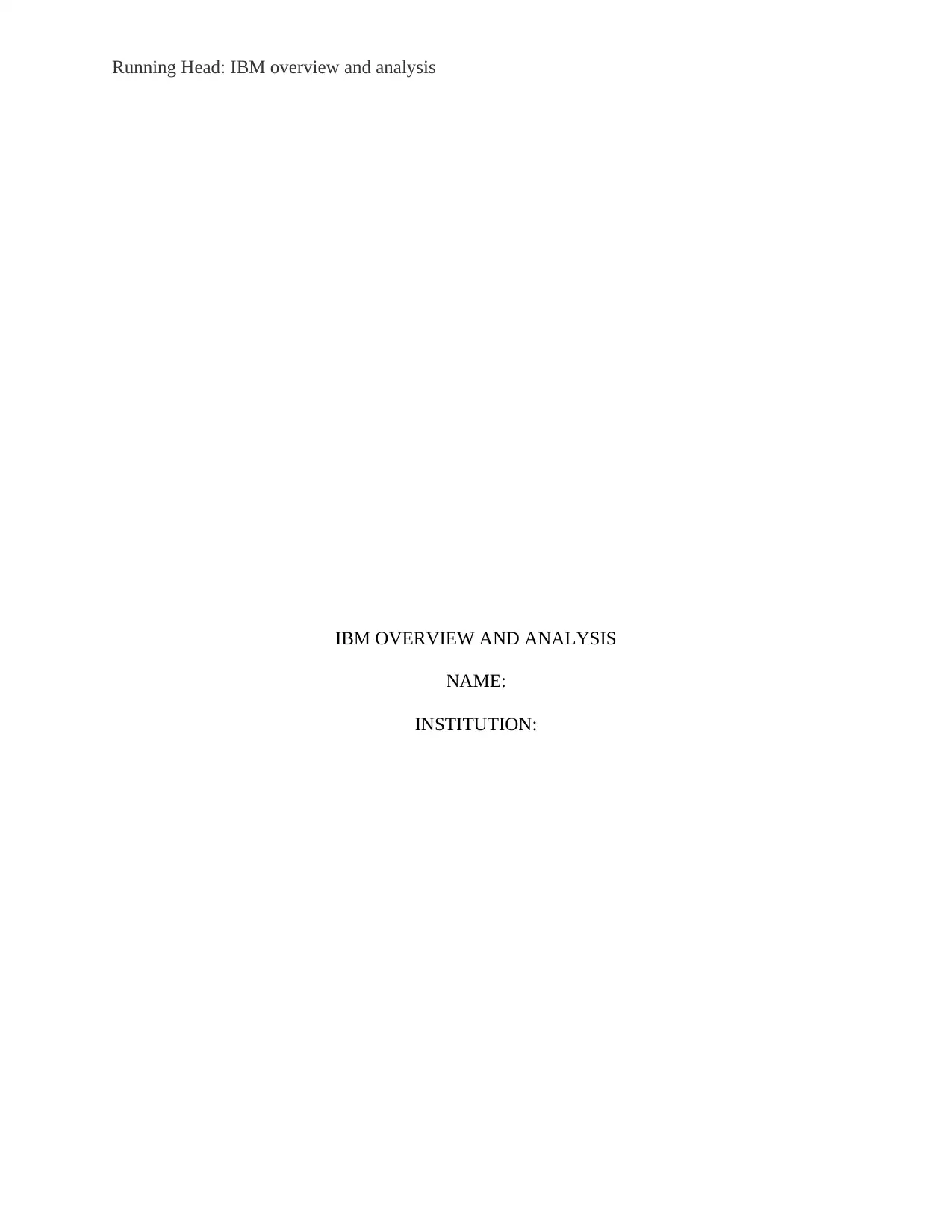
Running Head: IBM overview and analysis
IBM OVERVIEW AND ANALYSIS
NAME:
INSTITUTION:
IBM OVERVIEW AND ANALYSIS
NAME:
INSTITUTION:
Paraphrase This Document
Need a fresh take? Get an instant paraphrase of this document with our AI Paraphraser
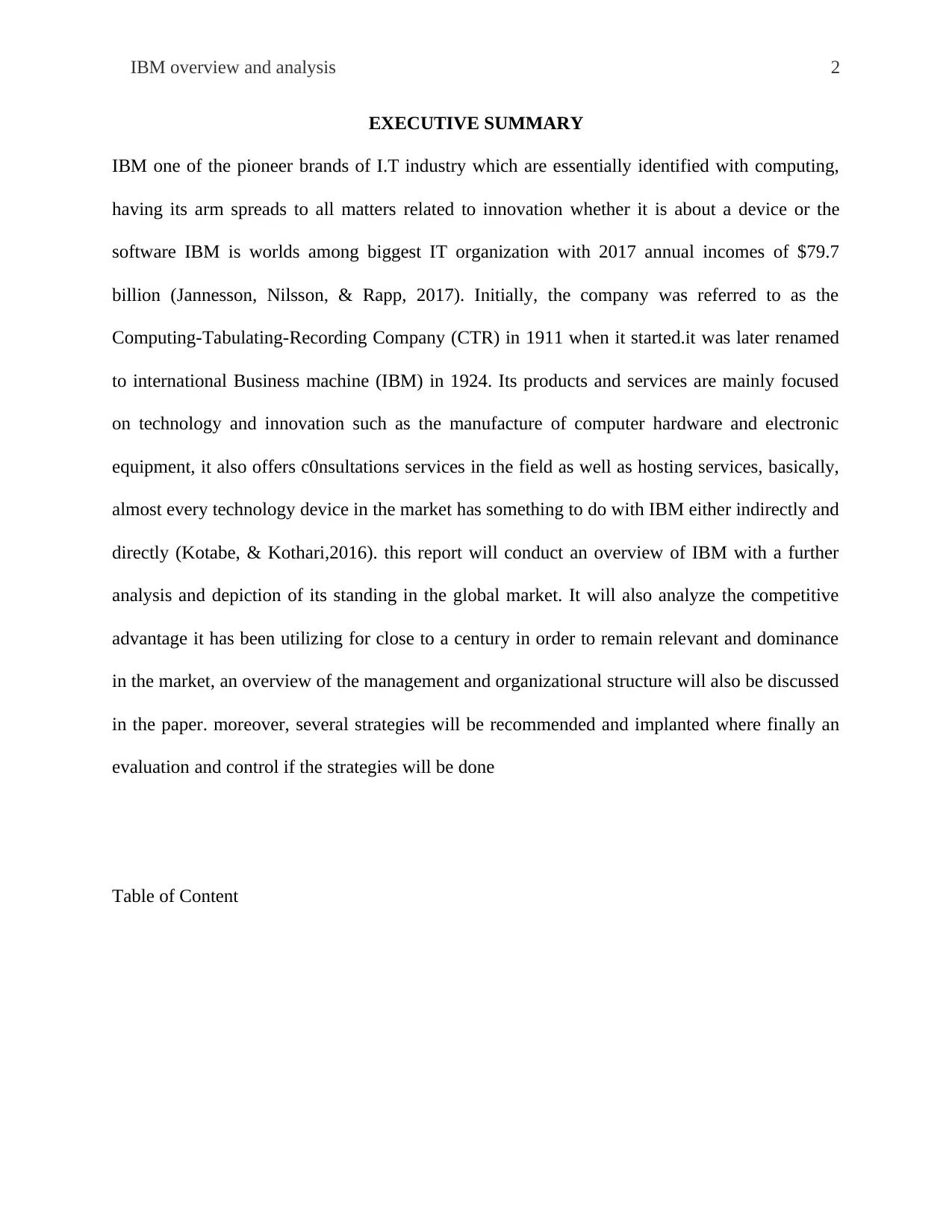
IBM overview and analysis 2
EXECUTIVE SUMMARY
IBM one of the pioneer brands of I.T industry which are essentially identified with computing,
having its arm spreads to all matters related to innovation whether it is about a device or the
software IBM is worlds among biggest IT organization with 2017 annual incomes of $79.7
billion (Jannesson, Nilsson, & Rapp, 2017). Initially, the company was referred to as the
Computing-Tabulating-Recording Company (CTR) in 1911 when it started.it was later renamed
to international Business machine (IBM) in 1924. Its products and services are mainly focused
on technology and innovation such as the manufacture of computer hardware and electronic
equipment, it also offers c0nsultations services in the field as well as hosting services, basically,
almost every technology device in the market has something to do with IBM either indirectly and
directly (Kotabe, & Kothari,2016). this report will conduct an overview of IBM with a further
analysis and depiction of its standing in the global market. It will also analyze the competitive
advantage it has been utilizing for close to a century in order to remain relevant and dominance
in the market, an overview of the management and organizational structure will also be discussed
in the paper. moreover, several strategies will be recommended and implanted where finally an
evaluation and control if the strategies will be done
Table of Content
EXECUTIVE SUMMARY
IBM one of the pioneer brands of I.T industry which are essentially identified with computing,
having its arm spreads to all matters related to innovation whether it is about a device or the
software IBM is worlds among biggest IT organization with 2017 annual incomes of $79.7
billion (Jannesson, Nilsson, & Rapp, 2017). Initially, the company was referred to as the
Computing-Tabulating-Recording Company (CTR) in 1911 when it started.it was later renamed
to international Business machine (IBM) in 1924. Its products and services are mainly focused
on technology and innovation such as the manufacture of computer hardware and electronic
equipment, it also offers c0nsultations services in the field as well as hosting services, basically,
almost every technology device in the market has something to do with IBM either indirectly and
directly (Kotabe, & Kothari,2016). this report will conduct an overview of IBM with a further
analysis and depiction of its standing in the global market. It will also analyze the competitive
advantage it has been utilizing for close to a century in order to remain relevant and dominance
in the market, an overview of the management and organizational structure will also be discussed
in the paper. moreover, several strategies will be recommended and implanted where finally an
evaluation and control if the strategies will be done
Table of Content
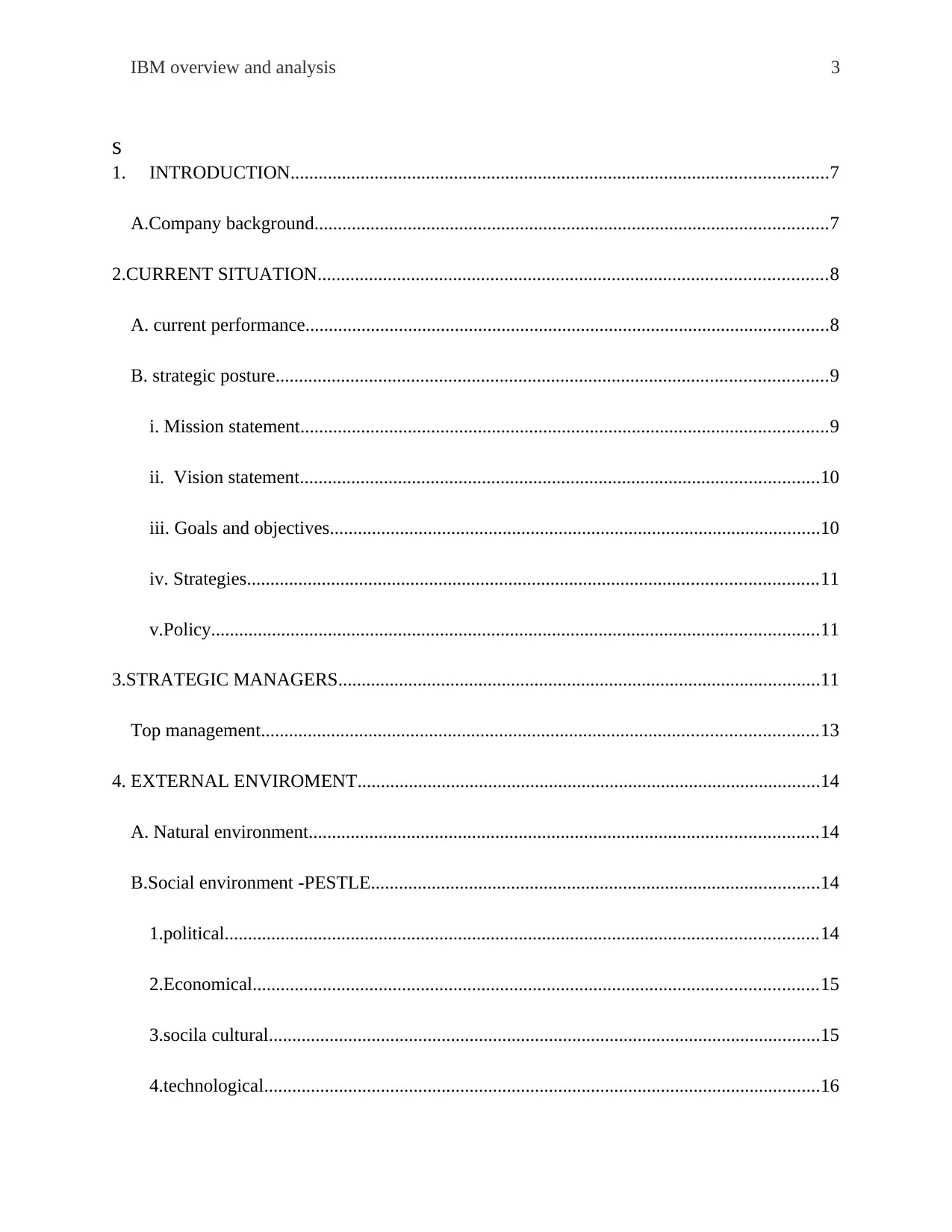
IBM overview and analysis 3
s
1. INTRODUCTION...................................................................................................................7
A.Company background..............................................................................................................7
2.CURRENT SITUATION.............................................................................................................8
A. current performance................................................................................................................8
B. strategic posture......................................................................................................................9
i. Mission statement.................................................................................................................9
ii. Vision statement...............................................................................................................10
iii. Goals and objectives.........................................................................................................10
iv. Strategies..........................................................................................................................11
v.Policy..................................................................................................................................11
3.STRATEGIC MANAGERS.......................................................................................................11
Top management.......................................................................................................................13
4. EXTERNAL ENVIROMENT...................................................................................................14
A. Natural environment.............................................................................................................14
B.Social environment -PESTLE................................................................................................14
1.political...............................................................................................................................14
2.Economical.........................................................................................................................15
3.socila cultural......................................................................................................................15
4.technological.......................................................................................................................16
s
1. INTRODUCTION...................................................................................................................7
A.Company background..............................................................................................................7
2.CURRENT SITUATION.............................................................................................................8
A. current performance................................................................................................................8
B. strategic posture......................................................................................................................9
i. Mission statement.................................................................................................................9
ii. Vision statement...............................................................................................................10
iii. Goals and objectives.........................................................................................................10
iv. Strategies..........................................................................................................................11
v.Policy..................................................................................................................................11
3.STRATEGIC MANAGERS.......................................................................................................11
Top management.......................................................................................................................13
4. EXTERNAL ENVIROMENT...................................................................................................14
A. Natural environment.............................................................................................................14
B.Social environment -PESTLE................................................................................................14
1.political...............................................................................................................................14
2.Economical.........................................................................................................................15
3.socila cultural......................................................................................................................15
4.technological.......................................................................................................................16
⊘ This is a preview!⊘
Do you want full access?
Subscribe today to unlock all pages.

Trusted by 1+ million students worldwide
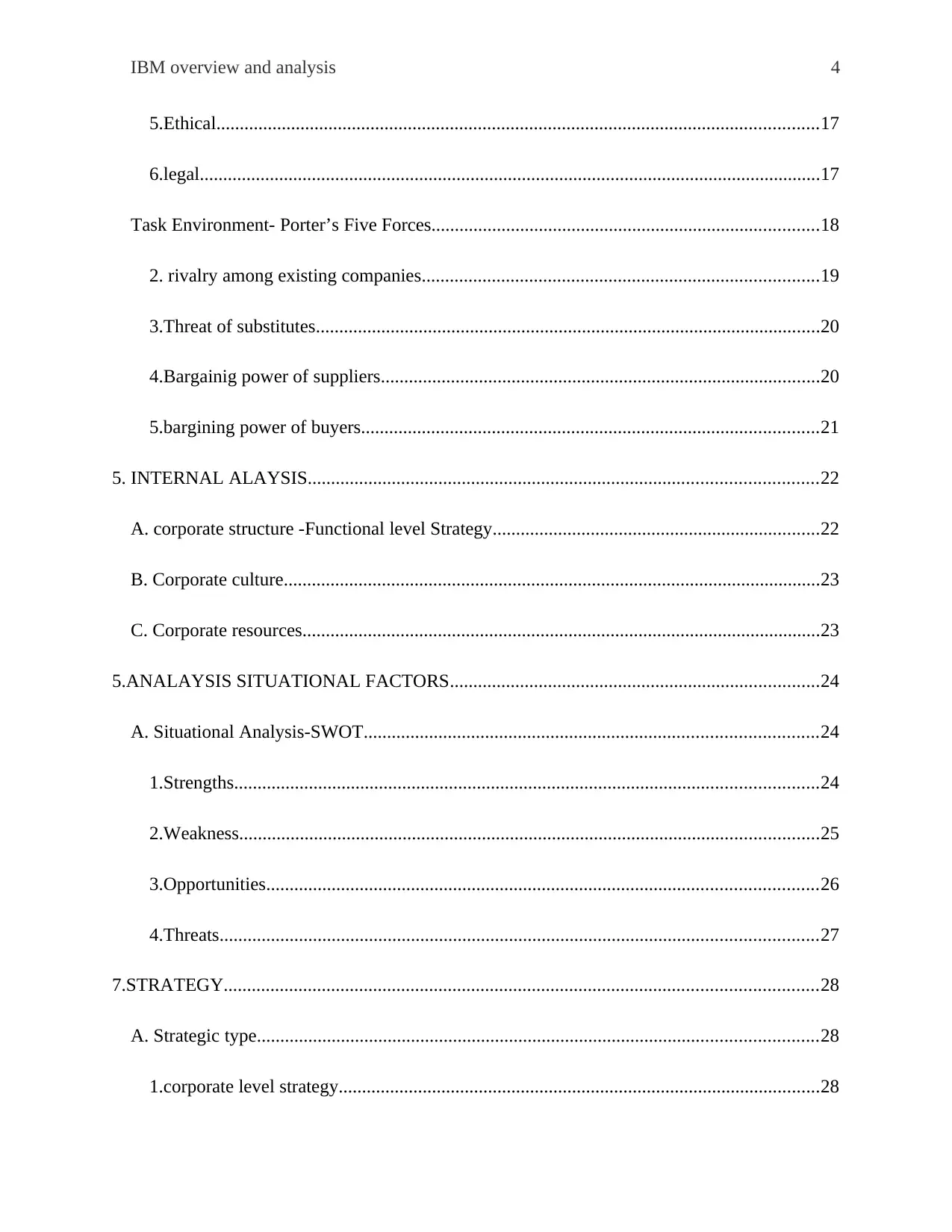
IBM overview and analysis 4
5.Ethical.................................................................................................................................17
6.legal.....................................................................................................................................17
Task Environment- Porter’s Five Forces...................................................................................18
2. rivalry among existing companies.....................................................................................19
3.Threat of substitutes............................................................................................................20
4.Bargainig power of suppliers..............................................................................................20
5.bargining power of buyers..................................................................................................21
5. INTERNAL ALAYSIS.............................................................................................................22
A. corporate structure -Functional level Strategy......................................................................22
B. Corporate culture...................................................................................................................23
C. Corporate resources...............................................................................................................23
5.ANALAYSIS SITUATIONAL FACTORS...............................................................................24
A. Situational Analysis-SWOT.................................................................................................24
1.Strengths.............................................................................................................................24
2.Weakness............................................................................................................................25
3.Opportunities......................................................................................................................26
4.Threats................................................................................................................................27
7.STRATEGY...............................................................................................................................28
A. Strategic type........................................................................................................................28
1.corporate level strategy.......................................................................................................28
5.Ethical.................................................................................................................................17
6.legal.....................................................................................................................................17
Task Environment- Porter’s Five Forces...................................................................................18
2. rivalry among existing companies.....................................................................................19
3.Threat of substitutes............................................................................................................20
4.Bargainig power of suppliers..............................................................................................20
5.bargining power of buyers..................................................................................................21
5. INTERNAL ALAYSIS.............................................................................................................22
A. corporate structure -Functional level Strategy......................................................................22
B. Corporate culture...................................................................................................................23
C. Corporate resources...............................................................................................................23
5.ANALAYSIS SITUATIONAL FACTORS...............................................................................24
A. Situational Analysis-SWOT.................................................................................................24
1.Strengths.............................................................................................................................24
2.Weakness............................................................................................................................25
3.Opportunities......................................................................................................................26
4.Threats................................................................................................................................27
7.STRATEGY...............................................................................................................................28
A. Strategic type........................................................................................................................28
1.corporate level strategy.......................................................................................................28
Paraphrase This Document
Need a fresh take? Get an instant paraphrase of this document with our AI Paraphraser

IBM overview and analysis 5
2.Business level strategies.....................................................................................................30
B. strategic group map...............................................................................................................30
8. STRATEGIC ALTERNATIVE AND RECOMMENDATIONS.............................................32
A. strategic alternatives.............................................................................................................32
B. Recommendations.................................................................................................................33
9.STRATEGY IMPLEMENTATION...........................................................................................33
10. EVALUATION AND CONTROL..........................................................................................34
11. CONCLUSION........................................................................................................................35
12.REFERENCES.........................................................................................................................36
2.Business level strategies.....................................................................................................30
B. strategic group map...............................................................................................................30
8. STRATEGIC ALTERNATIVE AND RECOMMENDATIONS.............................................32
A. strategic alternatives.............................................................................................................32
B. Recommendations.................................................................................................................33
9.STRATEGY IMPLEMENTATION...........................................................................................33
10. EVALUATION AND CONTROL..........................................................................................34
11. CONCLUSION........................................................................................................................35
12.REFERENCES.........................................................................................................................36

IBM overview and analysis 6
LIST OF FIGURES
1. Figure 1: IBM results of Q1 2018……………………………………………………. 9
2. Figure 2: IBM board of director experience and skills ………………………………12
3. Figure 3: IBM’s organizational structure ………………………………………….... 13
4. Figure 4: porter 5 analysis of IBM …………………………………………………...28
5. Figure 6: Strategic map brand equity…………………………………………………31
6. Figure 6: Strategic map brand equity…………………………………………………32
LIST OF FIGURES
1. Figure 1: IBM results of Q1 2018……………………………………………………. 9
2. Figure 2: IBM board of director experience and skills ………………………………12
3. Figure 3: IBM’s organizational structure ………………………………………….... 13
4. Figure 4: porter 5 analysis of IBM …………………………………………………...28
5. Figure 6: Strategic map brand equity…………………………………………………31
6. Figure 6: Strategic map brand equity…………………………………………………32
⊘ This is a preview!⊘
Do you want full access?
Subscribe today to unlock all pages.

Trusted by 1+ million students worldwide
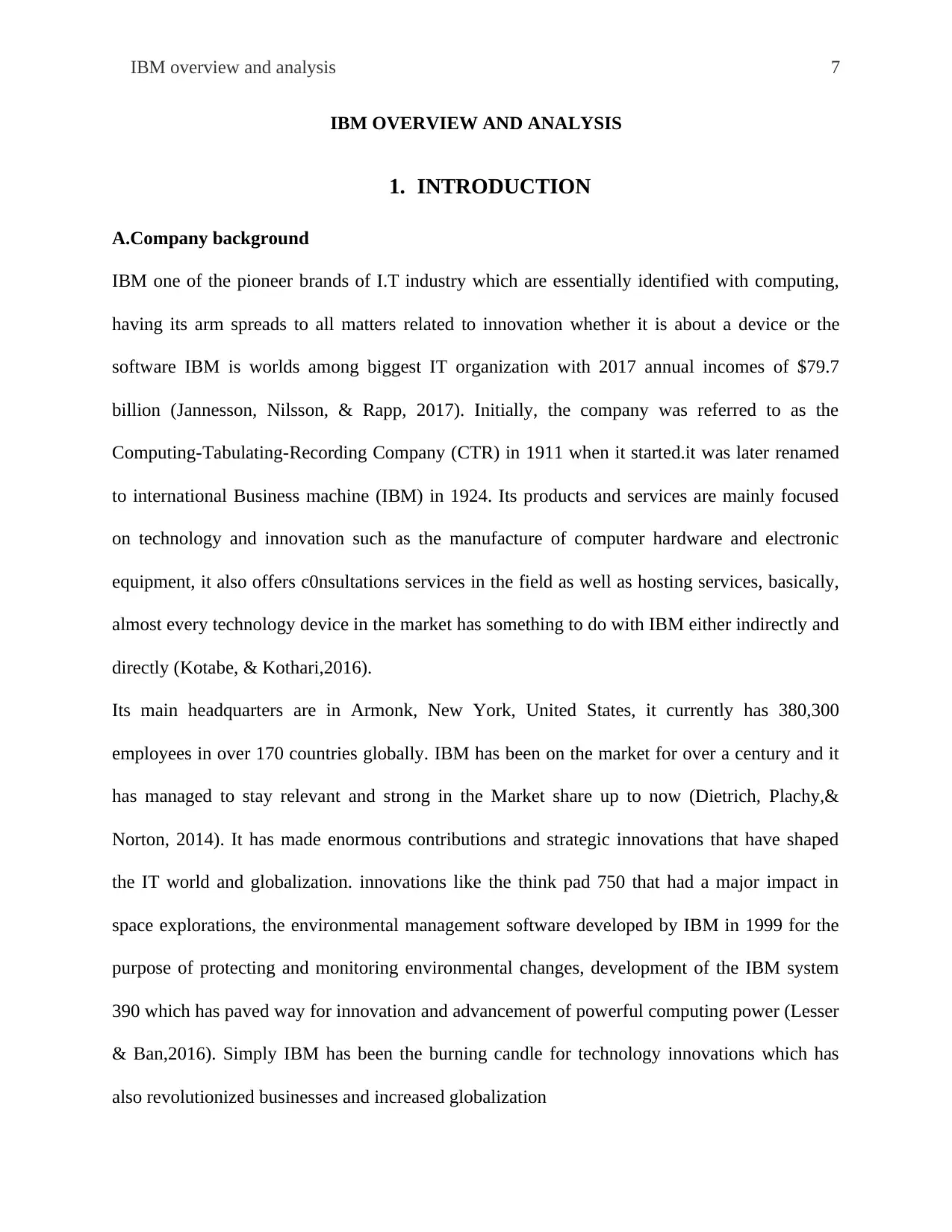
IBM overview and analysis 7
IBM OVERVIEW AND ANALYSIS
1. INTRODUCTION
A.Company background
IBM one of the pioneer brands of I.T industry which are essentially identified with computing,
having its arm spreads to all matters related to innovation whether it is about a device or the
software IBM is worlds among biggest IT organization with 2017 annual incomes of $79.7
billion (Jannesson, Nilsson, & Rapp, 2017). Initially, the company was referred to as the
Computing-Tabulating-Recording Company (CTR) in 1911 when it started.it was later renamed
to international Business machine (IBM) in 1924. Its products and services are mainly focused
on technology and innovation such as the manufacture of computer hardware and electronic
equipment, it also offers c0nsultations services in the field as well as hosting services, basically,
almost every technology device in the market has something to do with IBM either indirectly and
directly (Kotabe, & Kothari,2016).
Its main headquarters are in Armonk, New York, United States, it currently has 380,300
employees in over 170 countries globally. IBM has been on the market for over a century and it
has managed to stay relevant and strong in the Market share up to now (Dietrich, Plachy,&
Norton, 2014). It has made enormous contributions and strategic innovations that have shaped
the IT world and globalization. innovations like the think pad 750 that had a major impact in
space explorations, the environmental management software developed by IBM in 1999 for the
purpose of protecting and monitoring environmental changes, development of the IBM system
390 which has paved way for innovation and advancement of powerful computing power (Lesser
& Ban,2016). Simply IBM has been the burning candle for technology innovations which has
also revolutionized businesses and increased globalization
IBM OVERVIEW AND ANALYSIS
1. INTRODUCTION
A.Company background
IBM one of the pioneer brands of I.T industry which are essentially identified with computing,
having its arm spreads to all matters related to innovation whether it is about a device or the
software IBM is worlds among biggest IT organization with 2017 annual incomes of $79.7
billion (Jannesson, Nilsson, & Rapp, 2017). Initially, the company was referred to as the
Computing-Tabulating-Recording Company (CTR) in 1911 when it started.it was later renamed
to international Business machine (IBM) in 1924. Its products and services are mainly focused
on technology and innovation such as the manufacture of computer hardware and electronic
equipment, it also offers c0nsultations services in the field as well as hosting services, basically,
almost every technology device in the market has something to do with IBM either indirectly and
directly (Kotabe, & Kothari,2016).
Its main headquarters are in Armonk, New York, United States, it currently has 380,300
employees in over 170 countries globally. IBM has been on the market for over a century and it
has managed to stay relevant and strong in the Market share up to now (Dietrich, Plachy,&
Norton, 2014). It has made enormous contributions and strategic innovations that have shaped
the IT world and globalization. innovations like the think pad 750 that had a major impact in
space explorations, the environmental management software developed by IBM in 1999 for the
purpose of protecting and monitoring environmental changes, development of the IBM system
390 which has paved way for innovation and advancement of powerful computing power (Lesser
& Ban,2016). Simply IBM has been the burning candle for technology innovations which has
also revolutionized businesses and increased globalization
Paraphrase This Document
Need a fresh take? Get an instant paraphrase of this document with our AI Paraphraser
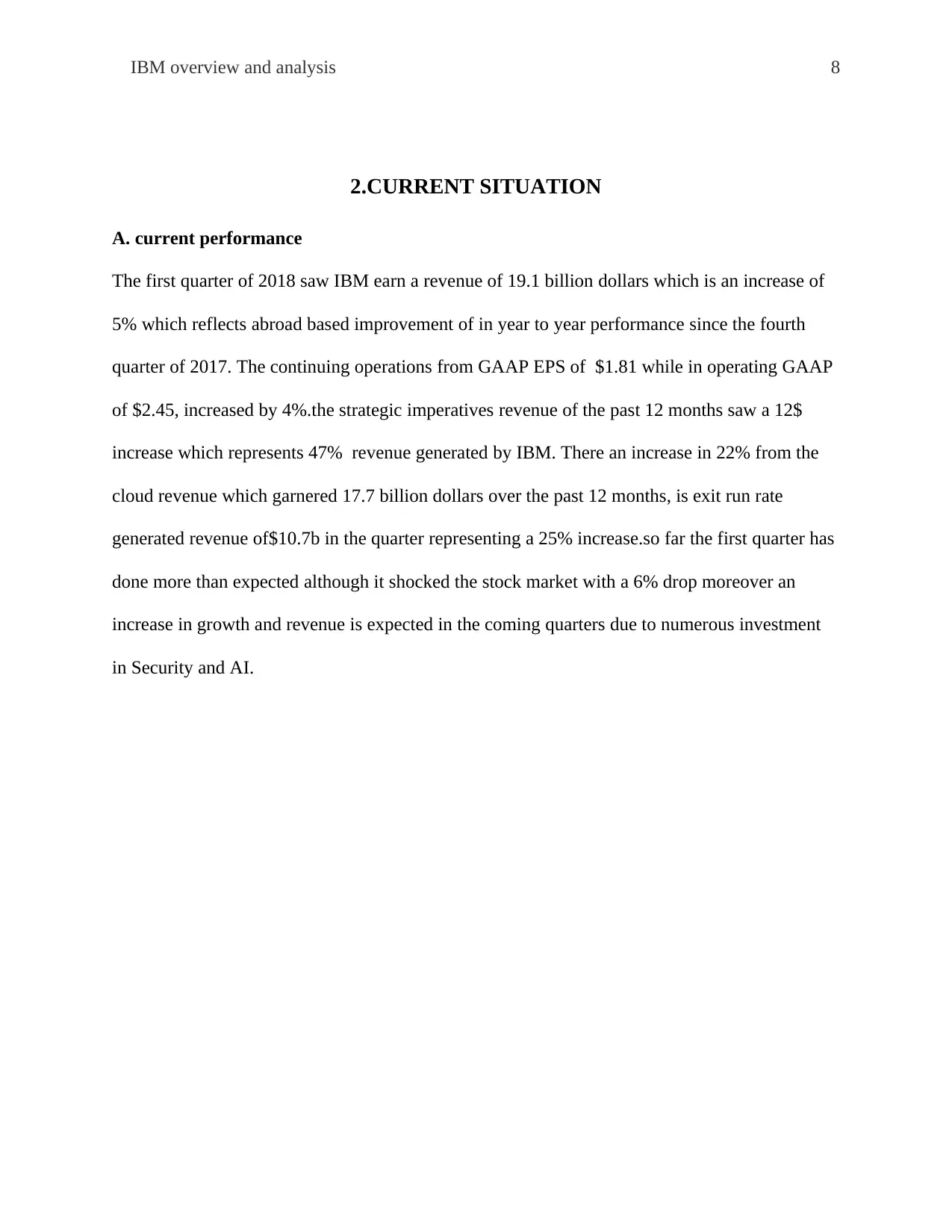
IBM overview and analysis 8
2.CURRENT SITUATION
A. current performance
The first quarter of 2018 saw IBM earn a revenue of 19.1 billion dollars which is an increase of
5% which reflects abroad based improvement of in year to year performance since the fourth
quarter of 2017. The continuing operations from GAAP EPS of $1.81 while in operating GAAP
of $2.45, increased by 4%.the strategic imperatives revenue of the past 12 months saw a 12$
increase which represents 47% revenue generated by IBM. There an increase in 22% from the
cloud revenue which garnered 17.7 billion dollars over the past 12 months, is exit run rate
generated revenue of$10.7b in the quarter representing a 25% increase.so far the first quarter has
done more than expected although it shocked the stock market with a 6% drop moreover an
increase in growth and revenue is expected in the coming quarters due to numerous investment
in Security and AI.
2.CURRENT SITUATION
A. current performance
The first quarter of 2018 saw IBM earn a revenue of 19.1 billion dollars which is an increase of
5% which reflects abroad based improvement of in year to year performance since the fourth
quarter of 2017. The continuing operations from GAAP EPS of $1.81 while in operating GAAP
of $2.45, increased by 4%.the strategic imperatives revenue of the past 12 months saw a 12$
increase which represents 47% revenue generated by IBM. There an increase in 22% from the
cloud revenue which garnered 17.7 billion dollars over the past 12 months, is exit run rate
generated revenue of$10.7b in the quarter representing a 25% increase.so far the first quarter has
done more than expected although it shocked the stock market with a 6% drop moreover an
increase in growth and revenue is expected in the coming quarters due to numerous investment
in Security and AI.
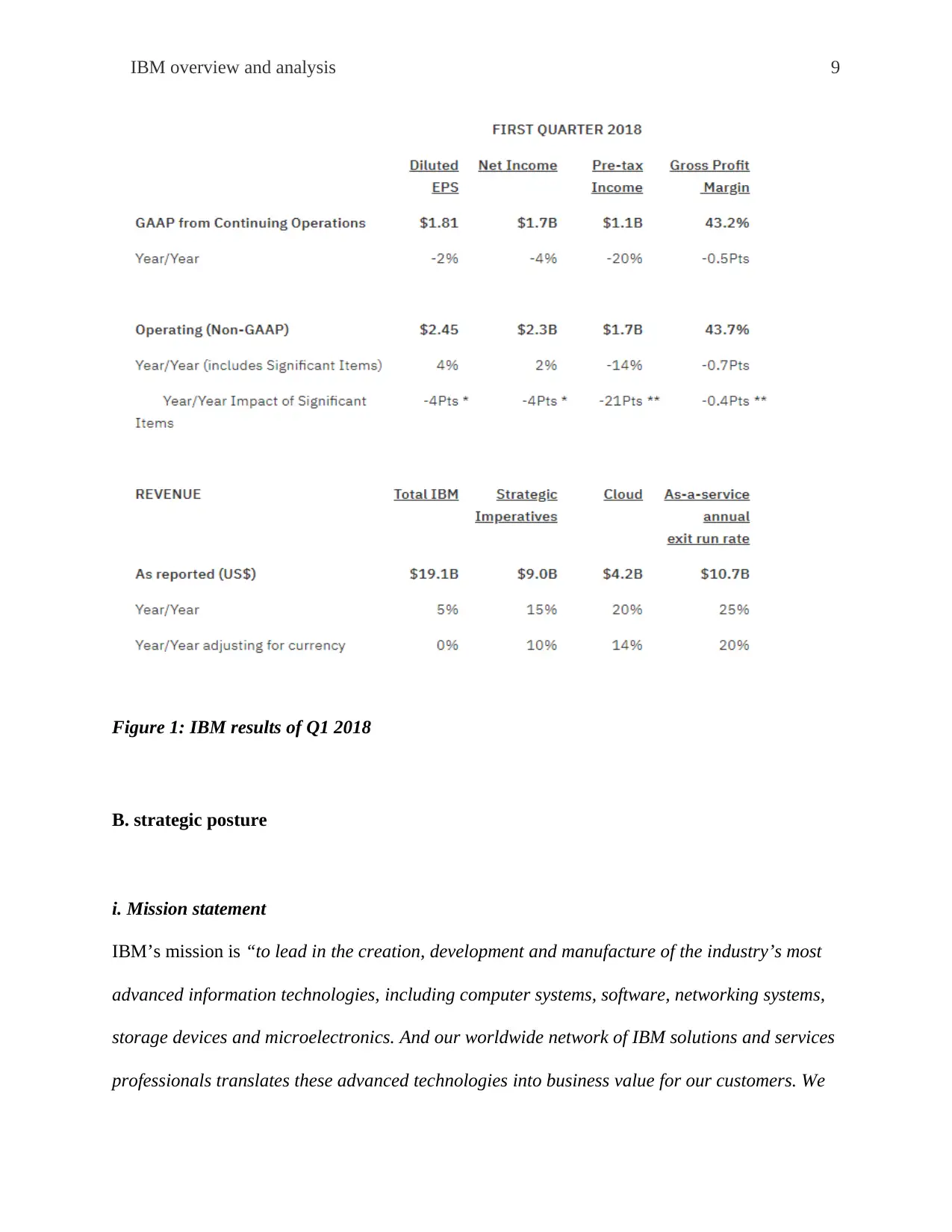
IBM overview and analysis 9
Figure 1: IBM results of Q1 2018
B. strategic posture
i. Mission statement
IBM’s mission is “to lead in the creation, development and manufacture of the industry’s most
advanced information technologies, including computer systems, software, networking systems,
storage devices and microelectronics. And our worldwide network of IBM solutions and services
professionals translates these advanced technologies into business value for our customers. We
Figure 1: IBM results of Q1 2018
B. strategic posture
i. Mission statement
IBM’s mission is “to lead in the creation, development and manufacture of the industry’s most
advanced information technologies, including computer systems, software, networking systems,
storage devices and microelectronics. And our worldwide network of IBM solutions and services
professionals translates these advanced technologies into business value for our customers. We
⊘ This is a preview!⊘
Do you want full access?
Subscribe today to unlock all pages.

Trusted by 1+ million students worldwide

IBM overview and analysis 10
translate these advanced technologies into value for our customers through our professional
solutions, services and consulting businesses worldwide.”
ii. Vision statement
IBM’s vision is “to be the world’s most successful and important information technology
company. Successful in helping out customers apply technology to solve their problems.
Successful in introducing this extraordinary technology to new customers. Important, because
we will continue to be the basic resource of much of what is invested in this industry.”
iii. Goals and objectives
IBM is fully focused on technology and innovation to maintains its market share as well as
impacts the technology world, below are the goals and objectives for IBM has for the next 5
years.
i. To make a smartphone that delivers a 3D image of individuals and their environment so
users can associate and for all intents and purposes SHOW what they are discussing.
ii. To make batteries that utilization oxygen to re-charge.
iii. To use officially exhibit innovation, for example, mass information arranges inside
organizations' yield vitality in a reused way that could really heat or cool buildings.
iv. To enhance transportation by a gadget that gives ALL potential outcomes for a driver's
conceivable courses to an area contemplating driver's examples, climate, development,
best modes, and so forth.
v. To utilize static or active vitality to work little gadgets, for example, the iPod without
batteries altogether.
vi. To utilize current innovation to assemble specific information, for example, information
about adjacent streams, quake information, et
translate these advanced technologies into value for our customers through our professional
solutions, services and consulting businesses worldwide.”
ii. Vision statement
IBM’s vision is “to be the world’s most successful and important information technology
company. Successful in helping out customers apply technology to solve their problems.
Successful in introducing this extraordinary technology to new customers. Important, because
we will continue to be the basic resource of much of what is invested in this industry.”
iii. Goals and objectives
IBM is fully focused on technology and innovation to maintains its market share as well as
impacts the technology world, below are the goals and objectives for IBM has for the next 5
years.
i. To make a smartphone that delivers a 3D image of individuals and their environment so
users can associate and for all intents and purposes SHOW what they are discussing.
ii. To make batteries that utilization oxygen to re-charge.
iii. To use officially exhibit innovation, for example, mass information arranges inside
organizations' yield vitality in a reused way that could really heat or cool buildings.
iv. To enhance transportation by a gadget that gives ALL potential outcomes for a driver's
conceivable courses to an area contemplating driver's examples, climate, development,
best modes, and so forth.
v. To utilize static or active vitality to work little gadgets, for example, the iPod without
batteries altogether.
vi. To utilize current innovation to assemble specific information, for example, information
about adjacent streams, quake information, et
Paraphrase This Document
Need a fresh take? Get an instant paraphrase of this document with our AI Paraphraser
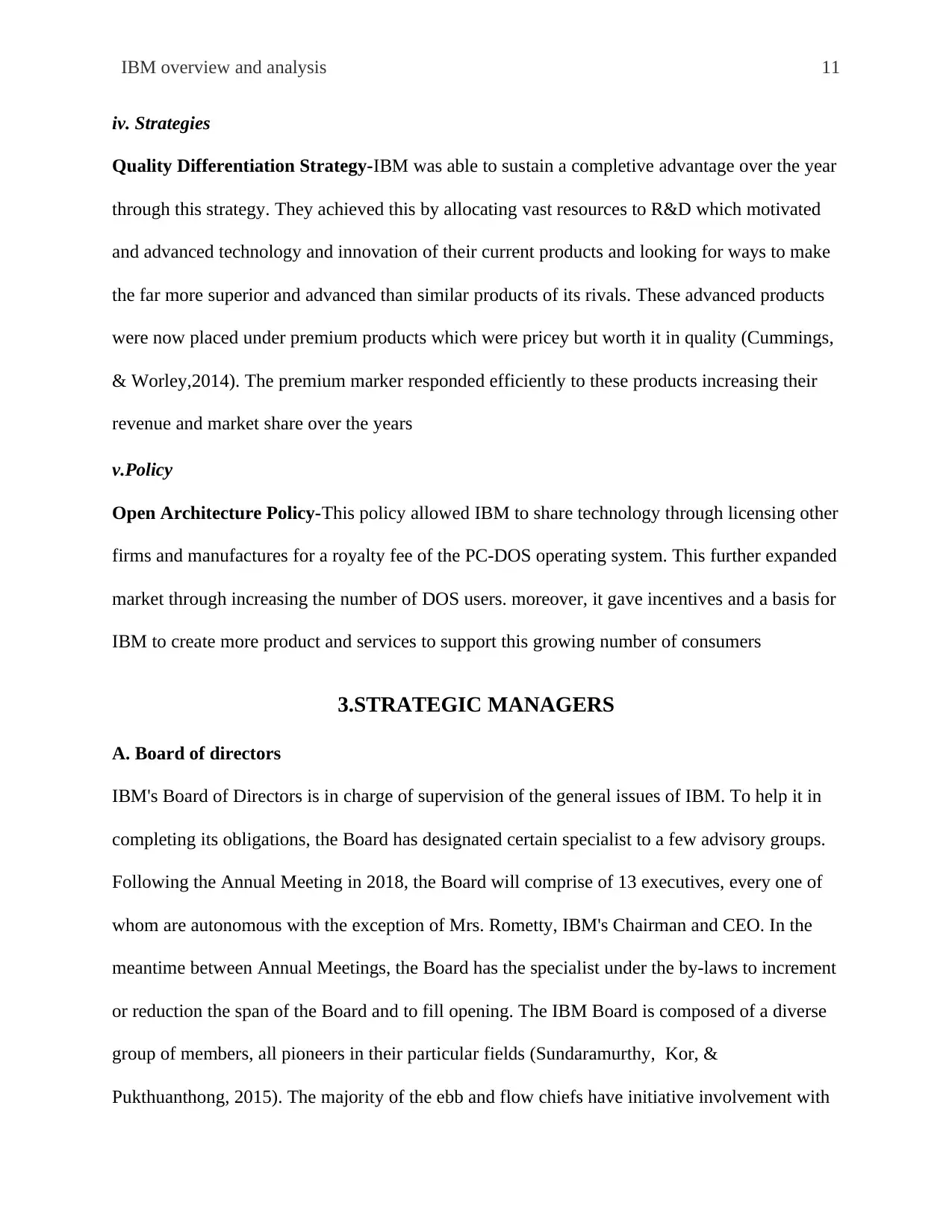
IBM overview and analysis 11
iv. Strategies
Quality Differentiation Strategy-IBM was able to sustain a completive advantage over the year
through this strategy. They achieved this by allocating vast resources to R&D which motivated
and advanced technology and innovation of their current products and looking for ways to make
the far more superior and advanced than similar products of its rivals. These advanced products
were now placed under premium products which were pricey but worth it in quality (Cummings,
& Worley,2014). The premium marker responded efficiently to these products increasing their
revenue and market share over the years
v.Policy
Open Architecture Policy-This policy allowed IBM to share technology through licensing other
firms and manufactures for a royalty fee of the PC-DOS operating system. This further expanded
market through increasing the number of DOS users. moreover, it gave incentives and a basis for
IBM to create more product and services to support this growing number of consumers
3.STRATEGIC MANAGERS
A. Board of directors
IBM's Board of Directors is in charge of supervision of the general issues of IBM. To help it in
completing its obligations, the Board has designated certain specialist to a few advisory groups.
Following the Annual Meeting in 2018, the Board will comprise of 13 executives, every one of
whom are autonomous with the exception of Mrs. Rometty, IBM's Chairman and CEO. In the
meantime between Annual Meetings, the Board has the specialist under the by-laws to increment
or reduction the span of the Board and to fill opening. The IBM Board is composed of a diverse
group of members, all pioneers in their particular fields (Sundaramurthy, Kor, &
Pukthuanthong, 2015). The majority of the ebb and flow chiefs have initiative involvement with
iv. Strategies
Quality Differentiation Strategy-IBM was able to sustain a completive advantage over the year
through this strategy. They achieved this by allocating vast resources to R&D which motivated
and advanced technology and innovation of their current products and looking for ways to make
the far more superior and advanced than similar products of its rivals. These advanced products
were now placed under premium products which were pricey but worth it in quality (Cummings,
& Worley,2014). The premium marker responded efficiently to these products increasing their
revenue and market share over the years
v.Policy
Open Architecture Policy-This policy allowed IBM to share technology through licensing other
firms and manufactures for a royalty fee of the PC-DOS operating system. This further expanded
market through increasing the number of DOS users. moreover, it gave incentives and a basis for
IBM to create more product and services to support this growing number of consumers
3.STRATEGIC MANAGERS
A. Board of directors
IBM's Board of Directors is in charge of supervision of the general issues of IBM. To help it in
completing its obligations, the Board has designated certain specialist to a few advisory groups.
Following the Annual Meeting in 2018, the Board will comprise of 13 executives, every one of
whom are autonomous with the exception of Mrs. Rometty, IBM's Chairman and CEO. In the
meantime between Annual Meetings, the Board has the specialist under the by-laws to increment
or reduction the span of the Board and to fill opening. The IBM Board is composed of a diverse
group of members, all pioneers in their particular fields (Sundaramurthy, Kor, &
Pukthuanthong, 2015). The majority of the ebb and flow chiefs have initiative involvement with
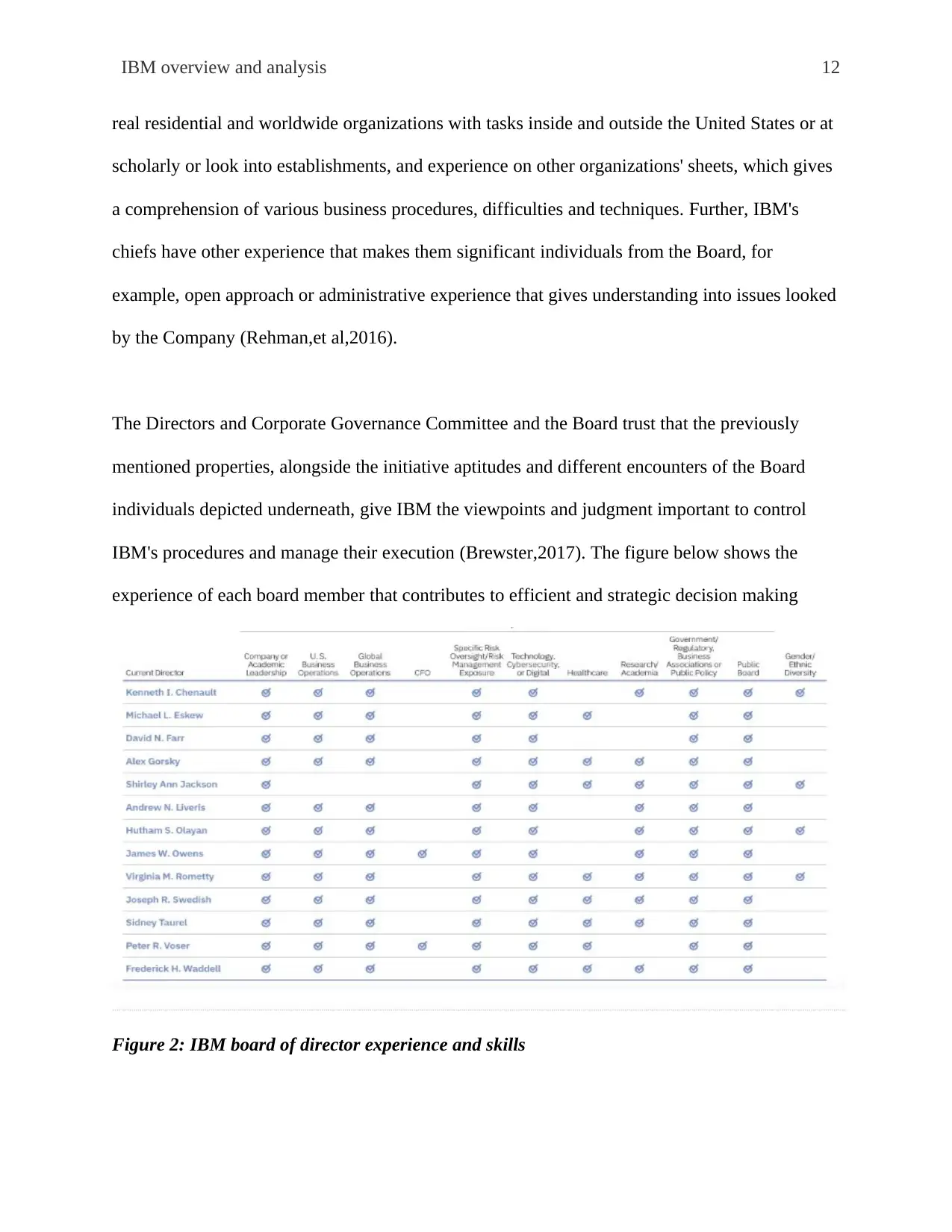
IBM overview and analysis 12
real residential and worldwide organizations with tasks inside and outside the United States or at
scholarly or look into establishments, and experience on other organizations' sheets, which gives
a comprehension of various business procedures, difficulties and techniques. Further, IBM's
chiefs have other experience that makes them significant individuals from the Board, for
example, open approach or administrative experience that gives understanding into issues looked
by the Company (Rehman,et al,2016).
The Directors and Corporate Governance Committee and the Board trust that the previously
mentioned properties, alongside the initiative aptitudes and different encounters of the Board
individuals depicted underneath, give IBM the viewpoints and judgment important to control
IBM's procedures and manage their execution (Brewster,2017). The figure below shows the
experience of each board member that contributes to efficient and strategic decision making
Figure 2: IBM board of director experience and skills
real residential and worldwide organizations with tasks inside and outside the United States or at
scholarly or look into establishments, and experience on other organizations' sheets, which gives
a comprehension of various business procedures, difficulties and techniques. Further, IBM's
chiefs have other experience that makes them significant individuals from the Board, for
example, open approach or administrative experience that gives understanding into issues looked
by the Company (Rehman,et al,2016).
The Directors and Corporate Governance Committee and the Board trust that the previously
mentioned properties, alongside the initiative aptitudes and different encounters of the Board
individuals depicted underneath, give IBM the viewpoints and judgment important to control
IBM's procedures and manage their execution (Brewster,2017). The figure below shows the
experience of each board member that contributes to efficient and strategic decision making
Figure 2: IBM board of director experience and skills
⊘ This is a preview!⊘
Do you want full access?
Subscribe today to unlock all pages.

Trusted by 1+ million students worldwide
1 out of 40
Related Documents
Your All-in-One AI-Powered Toolkit for Academic Success.
+13062052269
info@desklib.com
Available 24*7 on WhatsApp / Email
![[object Object]](/_next/static/media/star-bottom.7253800d.svg)
Unlock your academic potential
Copyright © 2020–2025 A2Z Services. All Rights Reserved. Developed and managed by ZUCOL.




